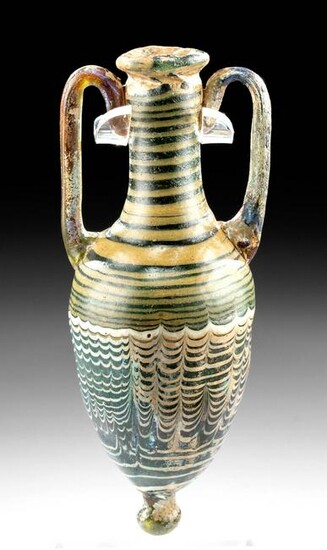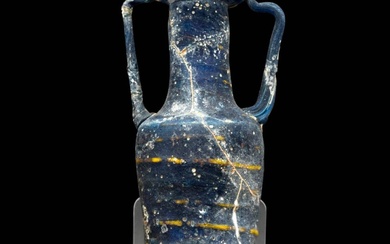Greek Hellenistic Core Formed Glass Amphoriskos
Ancient Greece, Hellenistic Period, ca. 2nd to 1st century BCE. A sumptuous example of a core-formed glass amphoriskos once used to hold perfumed oil. The vessel features an elegant piriform body with a protruding spherical base, a sloped shoulder that tapers to form a cylindrical neck, a flared rim surrounding a petite mouth, and a pair of applied handles arching between neck and shoulder. The blue-green glass comprising the main body is intricately decorated with spiraling yellow trails along the upper body as well as densely feathered trails of yellow-white glass along the lower body that gradually circles towards the yellow-green base. The handles exhibit either a sage-green or amber-yellow hue, and the entire vessel has developed fiery areas of rainbow-hued iridescence. Size: 2.375" W x 5.8" H (6 cm x 14.7 cm); 7.2" H (18.3 cm) on included custom stand.
Core-formed glass represents one of the earliest and most widely used forms of glass manufacture in the ancient world. The production of glass objects seems to have originated in western Asia around 1500 BCE, followed by an explosion in the Egyptian industry in the fifteenth century BCE. At around the same time, glass begins to be mentioned in written sources from Mesopotamia, suggesting its growing popularity. However, it was the Greeks and Romans who perfected the technology of glass making and considered it an art form. In around the middle of the sixth century, a technological breakthrough led to the creation of the first glass vessels and allowed the industry to become established in its own right. This was the core-forming technique, which was to remain the dominant method for the creation of vessels in the ancient world until the advent of glass-blowing in the first century BCE.
The technique involved shaping a core of clay and sand in the form of the vessel around a metallic rod. Then, molten glass was either trailed onto the core using a tool, or from dipping the core directly into a container of molten glass. To achieve a smooth surface, the vessel was continually reheated and rolled on a flat slab. Finally, the metallic rod was removed and, once the vessel had slowly cooled down, the core material was scraped out. The trailing of the vessel in molten glass led to aesthetically pleasing decorations in zigzag or feather patterns, in favoured colours of white and yellow, like the present piece. This delicate and intricate technique limited the size of the vessel; as such, these objects were often miniature forms of well-known vase types, designed to hold perfumes, scented oils and cosmetics.
The name of the vessel means 'little amphora', derived from the traditional vessel used to store wine or oil. Glass continued to remain a luxury material, although the production of small vessels for daily use extended its reach to a greater audience. The Hellenistic period, spanning the era from the conquests of Alexander the Great (356-323 BCE) to the inception of Roman imperial rule at the end of the first century BCE, was characterized by its love of luxury items created by master craftsmen for an increasingly affluent society. Glassmaking in its current form reached the pinnacle of its manufacture, with the exploration of different techniques and increasingly beautiful designs and forms.
For a strikingly similar example with a slender body profile, please see The Metropolitan Museum of Art, accession number 17.194.597.
For another stylistically similar example, please see: "Solid Liquid: Greek, Roman, Byzantine and Islamic Glass." Fortuna Fine Arts, Ltd., New York, 1999, p. 20, fig. 14.
Provenance: East Coast collection, New York Gallery, New York City, New York, USA, acquired before 2010
All items legal to buy/sell under U.S. Statute covering cultural patrimony Code 2600, CHAPTER 14, and are guaranteed to be as described or your money back.
A Certificate of Authenticity will accompany all winning bids.
PLEASE NOTE: Due to recent increases of shipments being seized by Australian & German customs (even for items with pre-UNESCO provenance), we will no longer ship most antiquities and ancient Chinese art to Australia & Germany. For categories of items that are acceptable to ship to Australia or Germany, please contact us directly or work with your local customs brokerage firm.
Display stands not described as included/custom in the item description are for photography purposes only and will not be included with the item upon shipping.
#149782
Condition Report: Professional repair to one handle, with nearly invisible break lines. Minor micro-bubbling within glass matrix, light pitting, and some abraded areas. Light earthen deposits and fabulous rainbow iridescence throughout.
View it on
Sale price
Estimate
Time, Location
Auction House
Ancient Greece, Hellenistic Period, ca. 2nd to 1st century BCE. A sumptuous example of a core-formed glass amphoriskos once used to hold perfumed oil. The vessel features an elegant piriform body with a protruding spherical base, a sloped shoulder that tapers to form a cylindrical neck, a flared rim surrounding a petite mouth, and a pair of applied handles arching between neck and shoulder. The blue-green glass comprising the main body is intricately decorated with spiraling yellow trails along the upper body as well as densely feathered trails of yellow-white glass along the lower body that gradually circles towards the yellow-green base. The handles exhibit either a sage-green or amber-yellow hue, and the entire vessel has developed fiery areas of rainbow-hued iridescence. Size: 2.375" W x 5.8" H (6 cm x 14.7 cm); 7.2" H (18.3 cm) on included custom stand.
Core-formed glass represents one of the earliest and most widely used forms of glass manufacture in the ancient world. The production of glass objects seems to have originated in western Asia around 1500 BCE, followed by an explosion in the Egyptian industry in the fifteenth century BCE. At around the same time, glass begins to be mentioned in written sources from Mesopotamia, suggesting its growing popularity. However, it was the Greeks and Romans who perfected the technology of glass making and considered it an art form. In around the middle of the sixth century, a technological breakthrough led to the creation of the first glass vessels and allowed the industry to become established in its own right. This was the core-forming technique, which was to remain the dominant method for the creation of vessels in the ancient world until the advent of glass-blowing in the first century BCE.
The technique involved shaping a core of clay and sand in the form of the vessel around a metallic rod. Then, molten glass was either trailed onto the core using a tool, or from dipping the core directly into a container of molten glass. To achieve a smooth surface, the vessel was continually reheated and rolled on a flat slab. Finally, the metallic rod was removed and, once the vessel had slowly cooled down, the core material was scraped out. The trailing of the vessel in molten glass led to aesthetically pleasing decorations in zigzag or feather patterns, in favoured colours of white and yellow, like the present piece. This delicate and intricate technique limited the size of the vessel; as such, these objects were often miniature forms of well-known vase types, designed to hold perfumes, scented oils and cosmetics.
The name of the vessel means 'little amphora', derived from the traditional vessel used to store wine or oil. Glass continued to remain a luxury material, although the production of small vessels for daily use extended its reach to a greater audience. The Hellenistic period, spanning the era from the conquests of Alexander the Great (356-323 BCE) to the inception of Roman imperial rule at the end of the first century BCE, was characterized by its love of luxury items created by master craftsmen for an increasingly affluent society. Glassmaking in its current form reached the pinnacle of its manufacture, with the exploration of different techniques and increasingly beautiful designs and forms.
For a strikingly similar example with a slender body profile, please see The Metropolitan Museum of Art, accession number 17.194.597.
For another stylistically similar example, please see: "Solid Liquid: Greek, Roman, Byzantine and Islamic Glass." Fortuna Fine Arts, Ltd., New York, 1999, p. 20, fig. 14.
Provenance: East Coast collection, New York Gallery, New York City, New York, USA, acquired before 2010
All items legal to buy/sell under U.S. Statute covering cultural patrimony Code 2600, CHAPTER 14, and are guaranteed to be as described or your money back.
A Certificate of Authenticity will accompany all winning bids.
PLEASE NOTE: Due to recent increases of shipments being seized by Australian & German customs (even for items with pre-UNESCO provenance), we will no longer ship most antiquities and ancient Chinese art to Australia & Germany. For categories of items that are acceptable to ship to Australia or Germany, please contact us directly or work with your local customs brokerage firm.
Display stands not described as included/custom in the item description are for photography purposes only and will not be included with the item upon shipping.
#149782
Condition Report: Professional repair to one handle, with nearly invisible break lines. Minor micro-bubbling within glass matrix, light pitting, and some abraded areas. Light earthen deposits and fabulous rainbow iridescence throughout.




